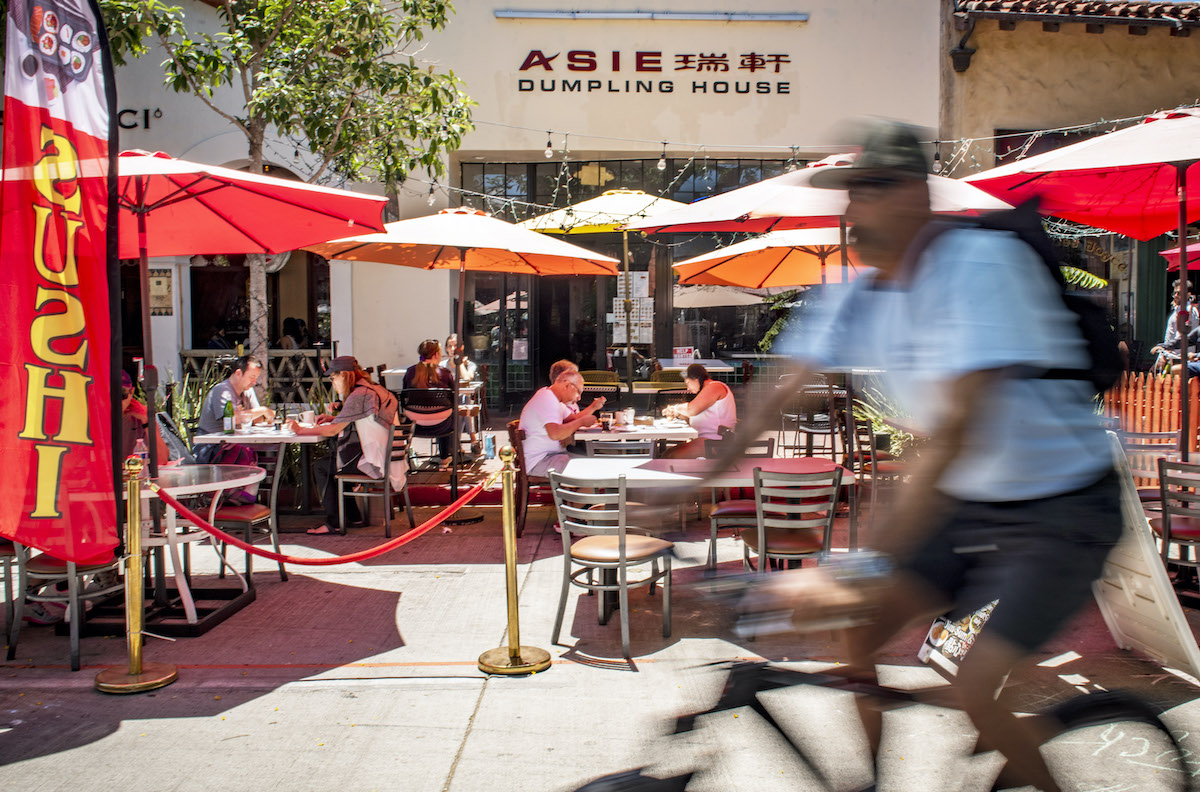The idea was dead on arrival, to force city restaurants still recovering from the financial bite of COVID-19 to redesign and reconstruct their outdoor parklets in a more uniform “Santa Barbara style.” The proposal came from City Hall staff, who said they had received complaints from local architects that the parklets — quickly built at the height of the pandemic when indoor dining was prohibited — don’t conform with the community’s “high aesthetic standards.”
On the table were recommendations to ban overhead elements (roofs, trellises, canopies, and string lights), astroturf, and “inappropriate” patio furniture. “Not indoor furniture that’s been repurposed and dragged outside,” explained Sarah Clark with the Public Works Department, who led the presentation to the City Council, “or cheap plastic lawn furniture that you would purchase at a hardware store.”
Only umbrellas would be allowed for shade, Clark explained, and only in pre-approved colors. Fencing would need to be made of wood or iron and be painted black or dark brown, and if it wasn’t, it would need to be fully screened with plantings to create “a more cohesive, garden-like appearance.”
Clark said the citywide proposals, scheduled to go into effect July 22, came out of consultations with volunteer representatives of the American Institute of Architects (AIA) and the city’s Historic Landmarks Commission (HLC). “A large majority of the enclosures out there at this point are not compliant,” she said. Staff also recommended that the city ban any new permanent parklets from being installed.
The response from both restaurant owners and the entire council was a resounding “no.” It didn’t matter that health restrictions had been lifted and businesses are now allowed to operate at full indoor capacity, they said. It will take restaurants many more months, if not years, to recoup the income they lost during COVID, and the last thing they need at the moment are more expenses and more regulations piled on top of them.
“This is a classic example of not including stakeholders who should have a voice in the matter, ” said bouchon owner Mitchell Sjerven, who politely but pointedly knocked the AIA and HLC for attempting to foist their personal visual ideals on struggling private operators. “We’re just trying to survive. We don’t have the luxury of volunteer services like those groups do.”
Ralph Barajas, owner of the Rose Café on the Mesa, said when he saw the proposed guidelines “it felt like the rug got pulled out from under my feet.” Barajas said he’d put a ton of time, effort, and money into making his parklet a pleasant and inviting space and forcing him to start over just wouldn’t be fair.
Moreover, Barajas explained, he’s still not comfortable filling his indoor dining room to full capacity, given some customers’ lingering fears over infection and others’ resistance to the vaccine. “We want to keep an open space and a safe environment, and the patio is a big part of that going forward,” he said.
Many members of the public also spoke out against the design changes. State Street is “better, cooler, and more fun” than it ever has been, one commenter said. “Aesthetic diversity is a good thing, and it’s part of the downtown experience now.” Another wondered why City Hall would do anything to mess with the success of the parklets and if staff were looking to solve a problem that doesn’t exist.
Councilmember Meagan Harmon agreed with those sentiments. “The best way to diminish excitement is to layer interim guidelines on top of regulations on top of interim guidelines,” she said. Plus, she went on, not only are the existing parklet rules set to expire in March 2022, when they may be renewed or modified, but City Hall is in the middle of forming a State Street Advisory Committee that will craft a long-term plan for downtown and its pedestrian promenade. Why fiddle with things now?
“It feels a bit random to me, frankly, to be requiring this right now,” said Harmon, explaining she hoped the council would take an approach that would “do the least harm.” “I really just want to see us get out of the way,” she said. That also means, she explained, allowing restaurants who either just opened or who just acquired the necessary funds to build their own new parklets.
Councilmember Michael Jordan said he found it more than a little ironic that the AIA and HLC would argue visual uniformity is what locals and tourists love so much about Santa Barbara, when precisely the opposite is helping drive the popularity of the patios and much-needed income to the region.
“Is there a way that as a city,” Councilmember Alejandra Gutierrez asked, “we can be more of a team player, instead of coming to businesses and being like ‘Bam! These are the new colors, no indoor furniture.’ Can we work with them?”
The council did, however, agree with staff that parklet-related issues over ADA access and blocked sidewalks needed to be addressed. Over the past year, disability rights advocates have often complained that tightly packed chairs and tables along sidewalks prevent wheelchairs from passing. And on Tuesday, Matt Lowe, speaking on behalf of the visually impaired, said he frequently bumps into signs, people, and planters when he walks downtown. “I would like some attention paid to this because it feels long overdue,” he said.
Clark lamented that staff hadn’t received “the cooperation we’ve needed” from businesses to keep the public right-of-way clear. Councilmember Kristen Sneddon called it “inexcusable” the problem has existed this long. The council unanimously decreed that by July 9, restaurants must clear their sidewalks of all tables and chairs, unless they had secured the necessary permits prior to the pandemic.
Support the Santa Barbara Independent through a long-term or a single contribution.




